 INTEGRAL News Archive [1995 - 2002]
INTEGRAL News Archive [1995 - 2002]
18 December 2002: Integral's first look at the gamma-ray Universe
ESA's gamma-ray satellite, Integral, is fully operational. Today Integral's
first ground-breaking images of the high-energy Universe were presented
in Paris, France. Astronomers call such initial observations 'first light'.
For more information, see the ESA Information Note Nr. 10-2002
18 December 2002: The INTEGRAL ISOC Newsletter #6 is available:
ISOC Newsletter #6
11
December 2002: ESA presents Integral's first images
Integral, the European Space Agency's gamma-ray satellite, has taken its
first images and collected its first scientific data. These "first-light"
images confirm that Integral is working superbly. Everyone involved with
the project is delighted with its performance so far.
Professor David Southwood (ESA Director of Science), Dr Arvind Parmar
(Integral's Acting Project Scientist), and the Principal Investigators
will be presenting Integral's first ground-breaking images and results
at a press conference on 18 December at ESA Headquarters in Paris, France.
For more information, see the ESA Press Relesase Nr. 79-2002
26
November 2002: Integral
localizes a long GRB (GRB 021125)
A. Bazzano, A. Paizis, and the INTEGRAL Science Team
report in GCN Circular 1706 the detection of GRB021125 at 17:58:30 UTC
with a duration of 20 sec in the IBIS field of view with the ISGRI and PICsIT
detectors.
The event is confirmed by the SPI anticoincidence system.
The burst peak intensity was about 2-4 Crab in the energy range
15-120 keV.
Also Ulysses, Mars Odyssey-HEND, RHESSI (GCN Circular 1707) and
Konus (GCN Circular 1709) observed this GRB.
Courtesy: K. Hurley, et al.
17
November 2002: First astronomical images obtained
by IBIS and SPI
During the night from 16 to 17 November, INTEGRAL
has been pointed towards Cygnus X-1 as a target for SPI commissioning phase
using a hexagonal dithering pattern. IBIS and SPI have obtained their first
astronomical images.
Courtesy: P. Ubertini, F. Lebrun, G. DiCocco and
the IBIS team & J. -P. Roques and the SPI team
13
November 2002: SPI detection of gamma-ray
line emission correlated with a solar proton flare
The SPI telescope aboard INTEGRAL has detected during the period from
9-Nov-2002 (12:00) and 11-Nov-2002 (12:00) a considerable increase of gamma-ray
line emission in the energy range 2-8 MeV. In particular,
broadened and shifted gamma-ray lines have been observed around 2216 keV,
3009 MeV, and 4452 keV. Increased but narrow gamma-ray line emission has
also been seen at 6129 keV.

The increase of gamma-ray line flux is correlated with an increase of
the SPI anticoincidence (ACS) overall counting rate, and an increase of
the 1-100 MeV proton flux as seen by GOES8 (see http://www.lmsal.com/solarsoft/last_events).
The origin of the gamma-ray lines is not fully understood so far, yet
the measurements impressively demonstrate the capacity of SPI to perform
detailed studies of gamma-ray line profiles. For example, the spectrum
at 2.2 MeV is composed of a narrow instrumental background line at the
rest energy of the deuterium line (2223 keV), and a broadened and possible
redshifted line with a mean energy of 2216 keV and a width of 16 keV (FWHM).
Subtracting off the instrumental background removes the narrow deuterium
line and reveals the excess emission during the flare period.
A more detailed study of the event and a more refined analysis of the
data, which were acquired only 5 days after the switch-on of the SPI Germanium
camera, is in progress.
Courtesy: Juergen Knoedlseder (CESR Toulouse) and the SPI team (13-Nov-2002)
11
November 2002: First performance results from
SPI
During temperature stabilisation process of the Germanium detectors,
spectra from SPI have been obtained at HV of 4000 V. The energy resolutions
of all detectors are nominal except for detector #15 which is slightly
worse: At the 1117.1 keV Ge69 background line the energy resolutions for
18 out of 19 detectors vary between 2.29 keV and 2.65 keV FWHM. Detector
#15 has not yet the nominal energy resolution (i.e. still 3.25 keV) which
will be improved by lowering the HV.
The spectrum for detector #0 (2.47 keV resolution @ 1117.1 keV)
is
shown here.
Courtesy: J.-P. Roques and the SPI team
08
November 2002: Full IBIS activation completed
Full IBIS nominal activation was completed 06
November. The IBIS parameter optimisation phase is planned to continue
for the next days. IBIS is now working in standard mode, with veto HV switched
on, PICSIT and ISGRI in nominal.
Click here for pictures showing
Courtesy: P. Ubertini, F. Lebrun, G. Di Cocco on
behalf of the IBIS Team
06
November 2002: SPI Ge detector temperature
of 90 K has beeen reached early
morning of 06 November. The energy resolution of the SPI Ge detectors
at 4000V are nominal except detector 15 which is slightly worse.
The HV of detector 15 will be adapted in order to find the best compromise.
....
more
01 November 2002: Final
operational orbit
After having successfully completed all orbit
transfer maneouvres the final mission orbit has been obtained with perigee
height of 9049.6 km and apogee height of 153657.2 km, inclination 52.246
degree.
30
October 2002 : First GRB detected by the SPI
anti-coincidence system
On October 27, 2002 around 8:34 UT the anti-coincidence
subsystem (ACS) of the INTEGRAL-spectrometer SPI has observed its first
gamma-ray burst (GRB). It could be seen already in the overall counting
rates of the anticoincidence subsystem (ACS) of SPI with 50 ms time resolution
(see figure 1 of the attachment).
Calculating the average over 10 time bins the burst becomes clearly visible
(see figure 2 of the attachment.
The time of the rise of the GRB is identical to the time of the burst GRB
021027 reported by the GCN. So we are confident that the ACS of SPI has
detected its first GRB! This detection shows that the ACS works as expected
and is able to trigger on GRBs. The SPI team considers this as a great
success.
Courtesy: A. v. Kienlin (MPE Garching) and the
SPI team.
29
October 2002: First light data from the second
JEM-X detector (JEM-X-2).
 First shadowgram obtained with JEM-X unit #2. Data show the expected smooth
shape with rim brigthening and gaps from calibration sources. Here you
can also obtain the first deconvolved images from JEM-X 2 (empty sky region) and
binned
detector spectra, showing the spectral evolution with increasing
high voltage.
First shadowgram obtained with JEM-X unit #2. Data show the expected smooth
shape with rim brigthening and gaps from calibration sources. Here you
can also obtain the first deconvolved images from JEM-X 2 (empty sky region) and
binned
detector spectra, showing the spectral evolution with increasing
high voltage.
Courtesy: Niels Lund (DSRI/Copenhagen) and Peter Kretschmar (ISDC/Geneva)
27
October 2002 : First light data from the first
JEM-X detector (JEM-X 1).
 First deconvolved image from JEM-X (1). Since the pointing was done on a practically empty field, with just a few very weak sources, no sources are detected in the ~ 2000 sec exposure.
First deconvolved image from JEM-X (1). Since the pointing was done on a practically empty field, with just a few very weak sources, no sources are detected in the ~ 2000 sec exposure.
Courtesy: Niels Lund (DSRI/Copenhagen) and Peter Kretschmar (ISDC/Geneva)
25
October 2002: First light data from the low
energy detector array ISGRI of the IBIS imager.
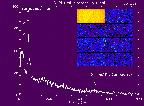 For thermal uniformity reasons, all 8 modules were powered but only
one module (shown in yellow)
For thermal uniformity reasons, all 8 modules were powered but only
one module (shown in yellow)
was biased to -120 V for about one hour. The module temperature was
around -10°C. On the picture one notes the good uniformity of the active
module and in the spectrum the W and CsI (probably) fluorescence lines
as well as a weak 511 keV line due to the calibration source. The threshold
was very low (close to 10 keV), it results in part from the exceptionally
low temperature.
This tests demonstates the excellent performance of ISGRI.
Courtesy: Francois Lebrun (CEA/Saclay), More info:
http://www-dapnia.cea.fr/Phys/Sap/Actualites/Depeches/126/depeches_dpy_win.php
Note that regular updates on IBIS can be found on the IBIS Homepage (IAS, Roma)
24 October 2002:
First light image from the Optical Monitor Camera (OMC) on-board INTEGRAL.
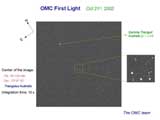
Courtesy: Miguel Mas-Hesse (LAEFF/INTA).For more information please see the OMC First Light page at LAEFF/INTA.
20 October
2002:
First light data from the high energy
detector array PICSIT of the IBIS imager.
 The
first
light image is showing the first
shadowgram of the detector module 1 of IBIS/PICsIT and the spectrum of
single events of the same module.
The
first
light image is showing the first
shadowgram of the detector module 1 of IBIS/PICsIT and the spectrum of
single events of the same module.
Courtesy: P. Ubertini, G. Di Cocco, T. Courvoisier
on behalf of IBIS and ISDC Teams.
18 October 2002 (II): Integral
early operations continue very smoothly.
18 October 2002 (I): SPI
and JEM-X digital electronics boxes were powered up as timelined. Integral
is in inertial pointing now and will do a slew to the outgassing attitude
later today.
17 October 2002: Integral
was succesfully launched at 06:41 from Baikonour; solar panels were deployed
succesfully; Integral is safe and in a stable configuration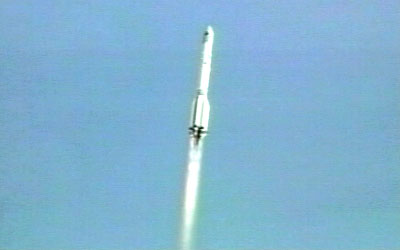
10 October 2002: 4th
stage with INTEGRAL mated with PROTON launcher
17 September 2002: Initial
perigee height updated to 9.000 km
The Flight Acceptance Review Board
recommended in July that the INTEGRAL Science Working Team re-assesses
the perigee height of the INTEGRAL orbit. It was decided to change the
baseline orbit and lower the perigee height by 1.000 km from 10.000 km
to 9.000km. The expected increase in the radiation environment is insignificant
and will not adversely affect the scientific products. The lowering of
the perigee will however save a substantial amount of fuel (20 kg equivalent
to 2-3 years of operation) and thus provide a healthy margin in the fuel
budget.
23 August 2002: INTEGRAL
shipment to Baikonur
Today, the INTEGRAL spacecraft
was transported from ESTEC to Amsterdam Schiphol Airport where it left
for Baikonur on-board a Russian Antonov 124
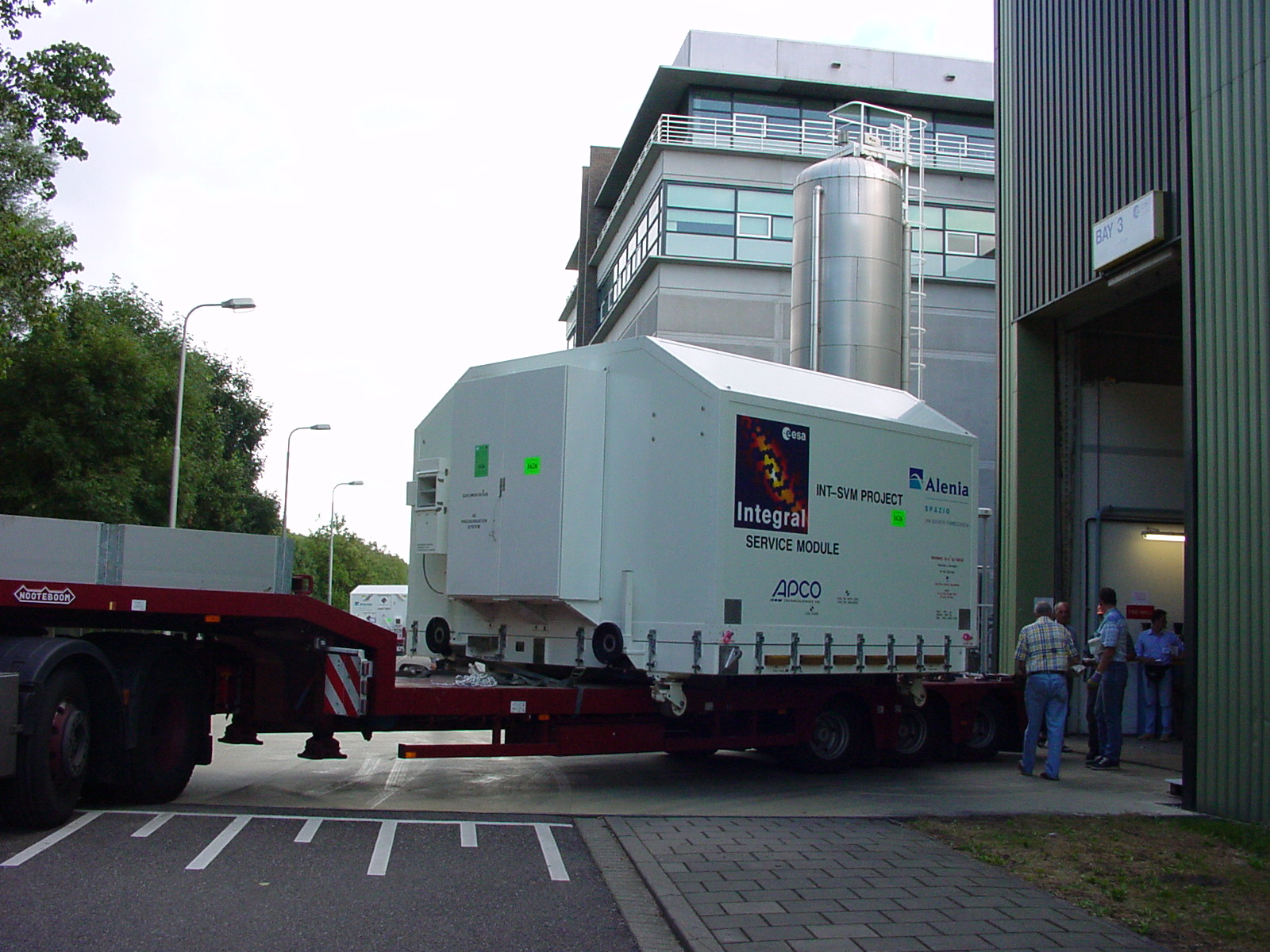
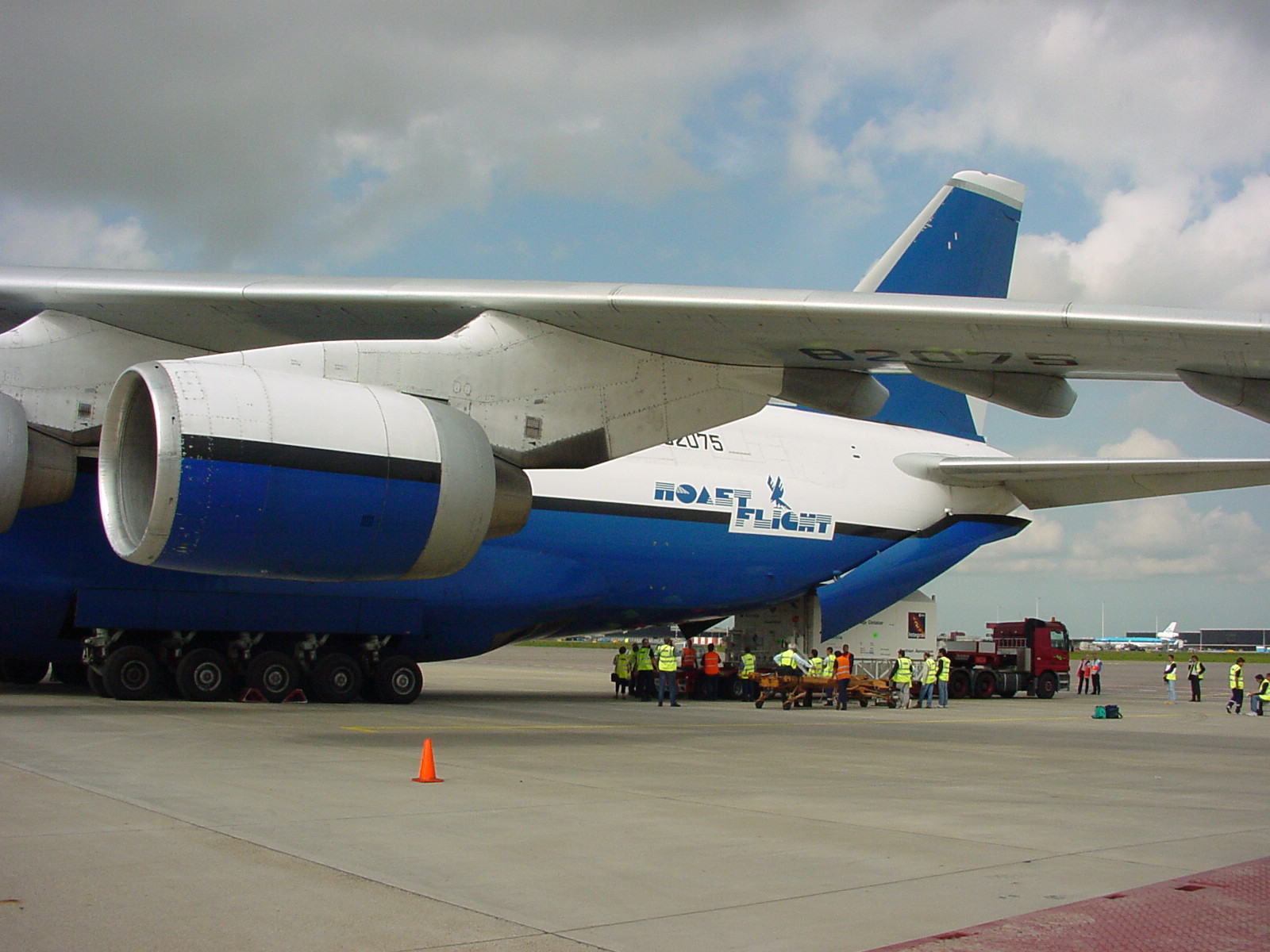

19 July 2002: INTEGRAL
Flight Acceptance Review completed
Today, the Flight Acceptance Review
Board met in ESTEC and concluded the flight readiness for the spacecraft,
instrument and ground segment.
June 2002: INTEGRAL
Ground Segment Readiness Review completed
The ESA internal review on the
readiness of the INTEGRAL operational and science ground segment has been
successfully completed.
May 2002: Instruments
Flight Acceptance Review completed
The ESA internal review on the
flight acceptance of the 4 INTEGRAL scientific instruments has been successfully
completed.
March 2002: Scientific
calibration on satellite level completed
The calibration has been completed
successfully. For further information see links to instrument sites and the Picture of the Month (March 2002).
28 January 2002: The INTEGRAL ISOC Newsletter #4 is available:
ISOC Newsletter #4
23 January 2002: The scientific calibration started at ESTEC
The full payload will be exposed
to radioactive sources in order to complement instrument level calibrations
and to provide cross-calibration for the high energy instruments. The activities
will last 2 weeks (24 h/day, 7d/week). Details can be found here
12 December 2001: Proceedings
4th INTEGRAL Workshop published.
The proceedings ESA SP-459 of the
4th INTEGRAL workshop ("Exploring the gamma-ray universe") have been published.
More information can be found here.
18 November 2001: IBIS
Detector Unit (FM) delivered to ESA.
The flight model of the IBIS imager
detector unit has been delivered to ESA on 18 November 2001. Integration
into the spacecraft has been performed subsequently. More details can be
found
here.
23 August 2001: INTEGRAL
AO-1 General Observer Programme (open time) approved.
The AO-1 General Observer Programme,
as approved by ESA can be found here.
An overview of the complete observing
programme including the Core Programme (guaranteed time) observations is
provided here.
16 August 2001: INTEGRAL Flight
Model: payload and service module have been mated.
The payload module and the service
module of the INTEGRAL FM have been mated in ESTEC.
Pictures showing the sequence can
be viewed here.
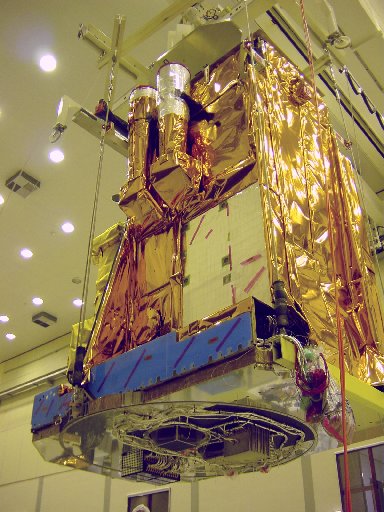
21 July 2001: INTEGRAL Flight
Model arrives at ESTEC for final testing
After being assembled by prime contractor
Alenia Spazio, INTEGRAL has now been delivered to
ESTEC in the Netherlands.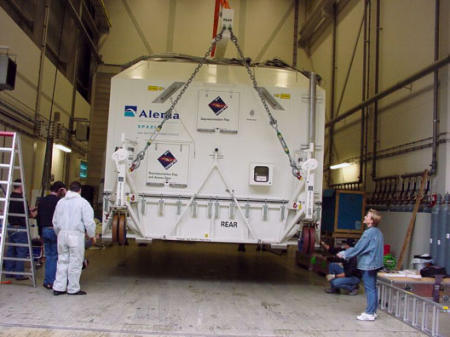
Environmental and system tests
are now to take place on the gamma-ray observatory in view of a
launch in October 2002.
More details can be found here.
9 July
2001: Recent INTEGRAL highlights
The past week(s) saw quite some
highlights for INTEGRAL including
-
Formal delivery of SPI to ESA 28/29
June (the SPI FM is in Alenia since May already)
-
IBIS/ISGRI FM delivery 6 July
-
New schedule
for launch date for 17/10/2002 due to schedule delay of the IBIS/PICSIT
flight model
-
First trucks with spacecraft flight
hardware and supporting equipments left the prime contractor Alenia in
Torino (Italy) and are arriving at ESTEC, the spacecraft flight model is
expected Friday 20 July in ESTEC
14 - 18 May 2001: Time Allocation
Committee peer reviews AO-1 proposals.
The peer review of the AO-1
guest observer proposals has begun. A story on the event can be found
here.
11 May 2001: SPI Flight Model
arrived at spacecraft
The SPI Flight Model has arrived
at Alenia (Turin, Italy) and is being mounted on the spacecraft. Pictures
can be found here.
08 May 2001: OMC Principal Investigator
Dr. Miguel Mas-Hesse (INTA/Madrid)
has been nominated PI for the OMC instrument. His predecessor, Dr. Alvaro
Gimenez stepped down as PI as he is taking up duties as Head of ESA's Space
Science Department as of 01 July.
18 April 2001: First results
from SPI scientific calibration
The INTEGRAL Spectrometer SPI
is currently in Bruyeres-le-Chatel (F) for the pre-launch scientific calibration
on instrument level. First results using radioactive sources at long (~
125 m) distance can be viewed here.
16 February 2001: AO-1 for open
time observing proposals
The
deadline for submitting AO-1 open time observing proposals has been reached.
Further information can be found in the ISOC Newsletter, #2.
15 December 2000: Spectrometer
SPI FM nearing completion
Following
the delivery of ESA's cryo-coolers last week, the SPI flight hardware is
now complete and testing of the integrated instrument proceeds at CNES
as scheduled.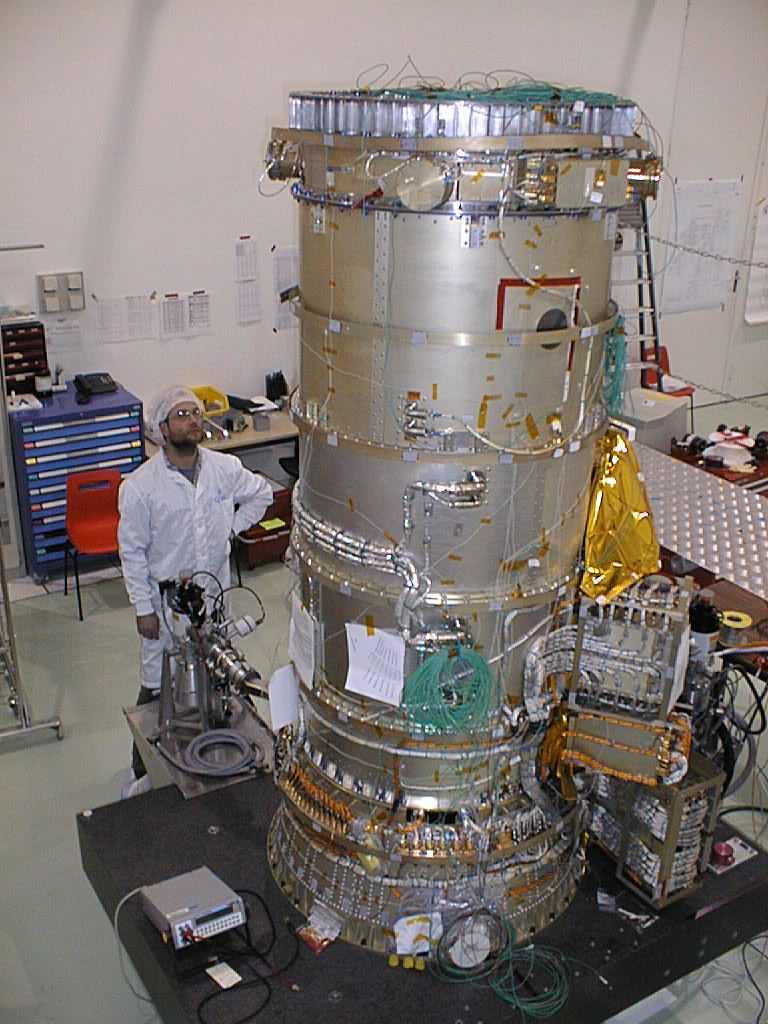
Images
of the SPI flight model hardware can be found here: Fig.1,
Fig.
2,
Fig.
3,Fig.
4
01 November 2000: ESA released
Announcement of Opportunity (AO-1)
Today,
the ESA Scientific Directorate has released the Announcement of Opportunity
(AO-1) for observing proposals
with
INTEGRAL. Further details can be found on the ISOC WWW page.
-
Announcement
for the release of the INTEGRAL AO-1 Call for Observing Proposals
10 October 2000: The flight
model of the OMC has been delivered to ESA
Today
the FM for the OMC has been officially delivered during a ceremony in INTA,
Madrid. OMC is the first FM instrument
delivererd
for INTEGRAL and the first PI instrument ever delivered from Spain to ESA.
19 September 2000: Response
to INTEGRAL AO-1: Call for Letters of Intent
By
the deadline of 15 Sep 2000 , the ISOC at ESA received 241 Letters of Intent,
with a total of approximately 700 proposals.
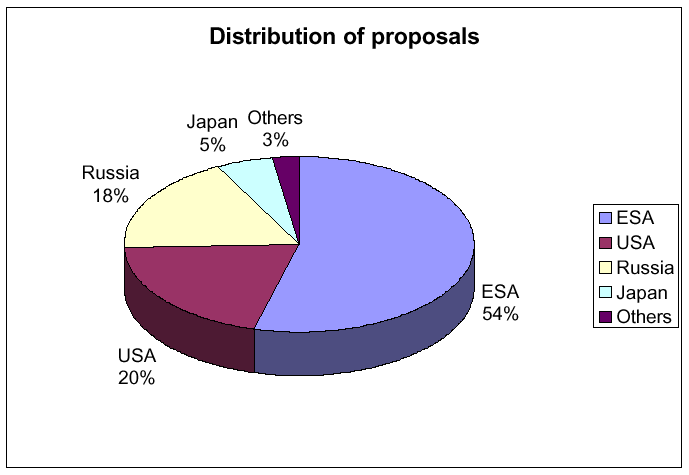
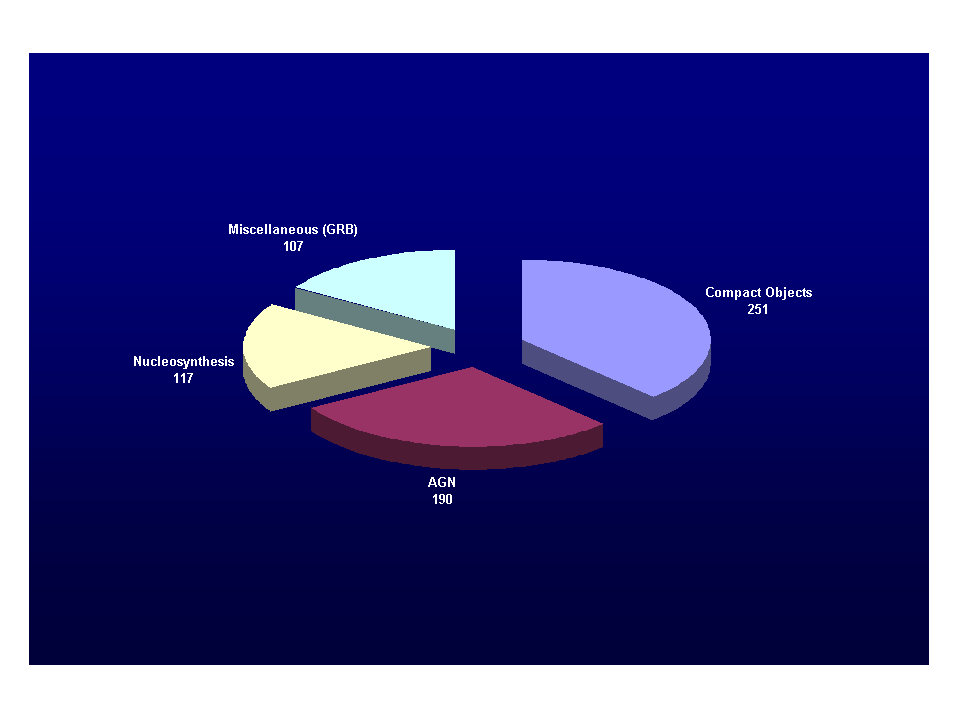
08 August 2000: 4th INTEGRAL
Workshop
More
than 230 scientists from all over the world met in Alicante from 4 - 8
Sep 2000 during the 4th INTEGRAL workshop
"Exploring
the gamma-ray universe" see
details on proceedings and deadlines
04 August 2000:INTEGRAL AO-1:
Call for Letters of Intent
In
view of the forthcoming INTEGRAL Announcement of Opportunity AO-1 you can
find here
the official Call for Letters of Intent and the Executive Summary
of the INTEGRAL AO-1.
04 June 2000: Compton GRO Mission terminated on
04 June 2000
On June 4, 2000, apx 9:00 am (GMT) the Compton GRO mission was terminated
via a controlled re-entry maneouvre.
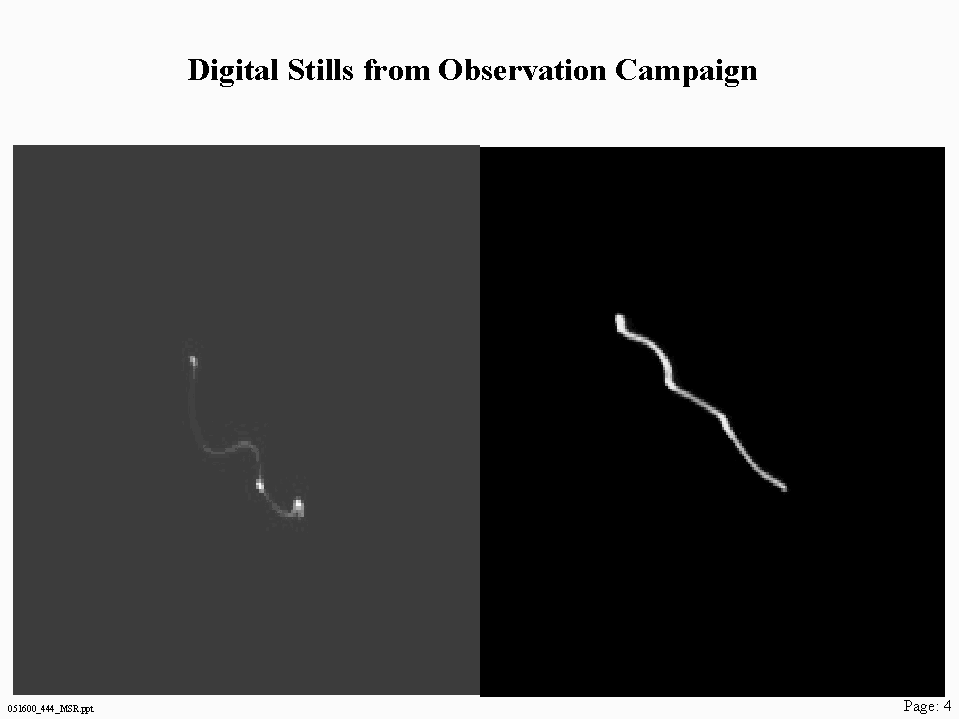 CGRO
re-entry
CGRO
re-entry
From: Alan Bunner (NASA HQ, Washington)
Date: June 01, 2000
Dear Colleagues,
This week witnesses the end of one of the most productive satellites
in the history of high energy astrophysics - the deorbiting of Compton
Gamma Ray Observatory. I want to take this opportunity to thank you all
for the fine efforts and scientific advances that have come from your participation
in this mission - spanning fields as diverse as solar physics, galactic
and extragalactic astronomy, cosmology. We transformed a Principal Investigator
satellite into a Great Observatory. We created a vigorous Guest Observer
community. We moved the field of gamma-ray astronomy from a peripheral
subject into mainstream astrophysics. With the early failure of tape recorders,
we turned adversity into opportunity and created a new discipline - rapid
response astrophysics. I share the deep disappointment that many of you
feel with the deliberate deorbiting of an operating spacecraft. This has
not been easy for any of us involved. I can only say that, from the point
of view of those faced with making such a difficult decision, engineers
and managers at GSFC and executives at NASA Headquarters, the mighty weight
of the responsibility for human lives has been hard to ignore. It's true
that risks are often considered acceptable in scientific research. But,
perhaps unlike defense research or medical research, gamma ray astrophysics
is not one of those fields where we can justify very much public risk.
Compton Observatory has returned nine years of productive science for a
mission designed for a two year life. NASA is rushing to complete HETE-2,
HESSI, Swift, and GLAST. ESA will launch INTEGRAL in early 2002. We will
soon have several new and improved tools for our trade in space. Meanwhile,
I thank you for your many contributions to promote this field and place
it center stage. You can be proud of this mission.
Sincerely,
Alan Bunner
Science Program Director, Structure and Evolution of the Universe
Alan.Bunner@hq.nasa.gov 202-358-0364
22 May 2000: 4th INTEGRAL Workshop: Scientific
Programme
The scientific programme has been established. Programme and abstracts
can be found here.
10 April 2000: New launch date 22 April 2002
During a payload status review held at ESTEC today, the overall instruments
and spacecraft schedules were discussed and the current launch date for
INTEGRAL was set to be 22 April 2002.
04 April 2000:
More than 80 astrophysicists from all over the world
travelled to the small town of Les Diablerets in the Swiss Alps to learn
how to use ESA's Integral satellite, once it is in orbit, to gather powerful
gamma-radiation coming from distant objects in the Universe.
More can be found here.
16 December 1999:
Proceedings 3rd INTEGRAL workshop (Taormina, Sep 1998)
The proceedings are available as volumes 38 and 39 (1999)
of Astrophysical Letters & Communications.
14 October 1999:
Signature of the launcher adaptation contract for INTEGRAL
The contract for the Proton Launcher Adaptation for Integral
was signed today at the ESA Permanent Mission in Moscow. This followed
the successful completion of a lengthy approval process for the Arrangement
between ESA and Russia on Cooperation on the Integral Project
Click
here for full story and images.
27 September 1999:
Call for papers: 4th INTEGRAL workshop
The first announcement (and call for papers) for the 4th INTEGRAL workshop
has been circulated to the scientific commuity at large. For further information
and deadlines please look at WWW pages of INTEGRAL workshop LOC.
20 September 1999: PROTON launcher approved by
Government of the Russian Federation
THE ARRANGEMENT BETWEEN THE EUROPEAN SPACE AGENCY AND THE RUSSIAN
SPACE AGENCY CONCERNING COOPERATION IN THE INTERNATIONAL GAMMA-RAY ASTROPHYSICS
LABORATORY (INTEGRAL) HAS BEEN APPROVED BY THE GOVERNMENT OF THE RUSSIAN
FEDERATION:
Moscow, September 20 (RIA-Novosti News Agency, translated from Russian)
The Government of the Russian Federation has approved the Arrangement
between the European Space Agency and the Russian Space Agency Concerning
Cooperation in the International Gamma-Ray Astrophysics Laboratory
(INTEGRAL).
The governmental Department of Information informed the RIA-Novosti
News
Agency that an appropriate instruction was signed by the Prime-Minister
Vladimir Putin.
According to this instruction, now included in the Russian Federal
Space Program
are the works related to the manufacturing of the PROTON launcher
(including
the nose fairing), the Upper Stage and the launch services, as well
as the task
of establishing a Russian Scientific Data Centre for the INTEGRAL
Project.
This work will be financed from the Federal Budget already provided
in the
Sections called "Space Research and Use" and "Fundamental Research
and
Development of the Scientific and Technical Progress".
The Ministry of Defense of Russia is allowed to participate, on
a contractual
base with the Russian Aviation and Space Agency, in the work related
to
implementation of the INTEGRAL Project.
---end---
August1999:
EM Programme completed
The spacecraft EM programme, conducted at the prime contractor's premises
(Alenia, Torino/Italy) has been completed. Instrument FM programmes are
underway.
08 July 1999:
Launch date
Following a review of instrument FM schedules the launch date has been
adjusted to 25 October 2001
25 March 1999:
Launch date
Following detailed mission analysis by ESOC, the INTEGRAL launch by
PROTON is foreseen for 11 September 2001.
March 1999:
3rd and 4th INTEGRAL workshops
The proceedings of the 3rd workshop (Taormina, Sep 1998) are in press.
Preparations for the 4th INTEGRAL workshop have begun. This workshop will take place in Alicante/Spain from 4-8 September 2000.
March 1999:
New Launch date
Following a payload development status and schedule review in January
1999, ESA decided to shift the launch of INTEGRAL to September 2001.
November 1998:
EM programme
After successfull completion of the STM programme, the EM AIV programme
has commenced at Alenia, prime contractor for INTEGRAL.
September 1998:
3rd INTEGRAL Workshop
The succesful series of INTEGRAL workshops continued with the 3rd INTEGRAL
workshop "The Extreme Universe" which was held 14 - 18 Sep 1998 in Taormina,
Sicily. More than 250 scientists gathered to review and discuss latest
observational and theoretical progress made on scientific topics related
to INTEGRAL research. Proceedings will be published in March 1999.
14 August 1998: Newsletter
The ESA INTEGRAL project team has published the first
issue of the INTEGRAL newsletter.
15 June 1998:
New orbit
The baseline INTEGRAL orbit using the PROTON launcher has been modified
and the new parameters are: orbital period 72 hours, (initial) inclination
51.6 deg, (initial) height of perigee: 10.000 km, (initial) height of apogee:
153.000 km
05 June 1998:
INTEGRAL STM programme
The spacecraft STM programme is in progress at ESTEC. The full spacecraft
(service module and payload module) is shown in these images:
The INTEGRAL spacecraft STM,
The INTEGRAL spacecraft
and representatives of the industrial consortium,
The INTEGRAL spacecraft STM above
the large solar simulator
Earlier images of the PLM can be accessed below.
02 June 1998:
SRD and Instrument h/w design review
The system requirement document (SRD) and the data package for the Instrument
hardware design review (IHDR) can be accessed via the "project documentation"
link.
25 May/2 June 1998:
INTEGRAL STM Programme
The testing of the INTEGRAL structural/thermal model is in "full swing"
at ESTEC. Pictures of the payload module during STM in ESTEC can be found
here:
Fig. 1, Fig.
2, Fig. 3, Fig.
4.
15 May 1998:
3rd INTEGRAL Workshop, Sep 1998, Taormina
The preliminary programme and apx 300 abstracts are now available on
the workshop web pages.
18 March 1998:
3rd INTEGRAL Workshop, Sep 1998, Taormina
The deadline for abstract submission (15 March) has been passed and
apx. 290 abstracts have been received by the LOC. Scheduling is in progress.
09 February 1998:
The ISOC software design is progressing well within in its SR phase.
Check out the ISOC SR Master Mind Map .
18 November 1997:
ESA and RKA sign Memorandum of Understanding
Today, Mr Koptev (Russian Space Agency) and Mr Rodota (ESA) have signed
the Memorandum of Understanding which confirms that the Russian PROTON
launcher will be used for INTEGRAL.
22 September 1997:
The 3rd INTEGRAL Workshop
The first circular and call for papers for the
3rd INTEGRAL workshop (14 - 18 Sep 1998, Taormina, Italy) has been
published.
04 September 1997:
Mass Model results
The SPI and IBIS pages provide now a direct link with the Southampton
Mass Model results (Monte Carlo simulations for background, efficiency,
sensitivity).
01/02 July 1997:
INTEGRAL SWT meeting #8
The ISWT met in Rome (CNR headquarters). The agenda included status
reports on instrument development, spacecraft and ground segment including
launcher status. The gamma-ray burst detection processes from on-board
to on-ground were reviewed. Data right issues concerning targets of opportunity
and targets in the field of view were discussed.
09 June 1997:
INTEGRAL Orbits
The INTEGRAL (initial) operational orbits have been modified as follows:
BASELINE (Proton): apogee 75000 km, perigee 46000 km, inclination 51.6
deg, argument of perigee 284 deg, orbital period 48 hrs, max eclipse duration
1.8 hrs, BACK-UP (ARIANE 5): apogee 114000 km, perigee 7000 km, inclination
65 deg, argument of perigee 280 deg, orbital period 48 hrs, max eclipse
duration 1.5 hrs
03 April 1997:
2nd INTEGRAL Workshop St Malo
The proceedings have been printed and mailing to workshop participants
is underway. To obtain additional copies, please consult the workshop
WWW page.
25/26 February 1997:
INTEGRAL Science Working Team Meeting #7
During its 7th meeting on 25/26 Feb the status of spacecraft, instruments
and science ground segment was reported. Instruments are entering phase
C/D. The spacecraft will undergo a Detailed Design Review in May 1997.
Instrument sensitivities and design status after Instrument Baseline Design
Review (Jan/Feb) have been presented. A baseline strategy for the Galactic
Plane scans of the Core Programme has been adopted.
29 January 1997:
INTEGRAL science telemetry and St Malo workshop
Following a recommendation from the ISWT at its last meeting, the project
agreed to increase the total INTEGRAL telemetry allocation from 70 kbps
to 90 kbps. The total allocation to instruments is 85.8 kbps (including
instrument housekeeping).
All papers submitted for the proceedings of the INTEGRAL workshop
(Sep 1996, Saint Malo/France) have been refereed and final papers have
been re-submitted by all authors. Publication of the proceedings is scheduled
for March 1997.
02 January 1997:
INTEGRAL Science Working Team Meetings #5 and #6 and 2nd INTEGRAL Workshop
St. Malo
The ISWT gathered in October and December 1996 for the 5th and 6th meeting.
Main items which were presented and discussed included the share of the
science telemetry, in particular for the IBIS instrument; the current status
of the launchers and ground segment; planning of the core programme; on
ground rapid response to GRB detections; mass modelling, simulations and
instrument sensitivities; science operations concept; baseline dithering
patterns.
Prof Herb Schnopper retired in 1996 as director of DSRI/Copenhaguen
and as PI of JEM-X. Herb will remain Co-I in the INTEGRAL/JEM-X collaboration
led by Dr Niels Lund/DSRI as PI.
Almost all papers for the proceedings of the 2nd INTEGRAL workshop
(St Malo, Sep 1996) have passed the referee process and final papers are
being received.
23 September 1996:
2nd INTEGRAL Workshop St. Malo
Over 200 participants have attended a very exciting workshop. The page
for the 2nd INTEGRAL workshop in St. Malo
has been updated. You will find there: Final Scientific programme, abstracts
and schedule, note to authors, and preparation kit for camera-ready papers.
10 June 1996:
INTEGRAL Related Publications
A list of related INTEGRAL publicationswill be maintained on the WWW from now on.
29/30 May 1996:
INTEGRAL Science Working Team Meeting #4
During the two-day meeting, the status of the project, instruments,
the data centre and ground segment was reviewed and related issues discussed
in detail. The instrument science verification review and the ISDC user
requirements review are completed. Progress is being made on the issues
of common ground payload calibration, on-board handling of GRB triggers,
core programme planning, various issues of data rights (ie. TOO's), and
mass model. Next major activity is the Spaceraft and Ground Segment Preliminary
Design Review (kick-off 11 June) which terminates Phase B.
23 May 1996:
INTEGRAL workshop
Over 177 abstracts have been received. Programme information and scheduling
of papers will be made available in July 1996.
10 April 1996:
Update INTEGRAL WWW pages for ISDC
The "User requirement review" for the ISDC is on-going (until Mid May
96). Some updates to the ISDC pages have been implemented.
19 March 1996:
Update INTEGRAL WWW pages
Following the Instrument Science Verification Review and on-going activities
in the spacecraft and ground segment areas have led to a review and update
af allmost all INTEGRAL WWW pages.
08 February 1996:
Experiment Interface Document (A)
The updated EID-A (rev. 2) is now available as PDF file in the INTEGRAL
Project Documentation section.
06 February 1996:
2nd INTEGRAL Workshop St. Malo
The page for the 2nd INTEGRAL workshop
in St. Malo has been updated. You will find there: 2nd circular and
call for papers, workshop registration and hotel accommodation forms, preparation
kits for abstracts and camera-ready papers.
02 February 1996:
Updates to the INTEGRAL WWW page
We now have included a link to INTA/Madrid, the home of the OMC. Also
the INTEGRAL Project Documentation area has been revised. Please refer
to overview page.
23/24 January 1996:
INTEGRAL Science Working Team Meeting #3
During the two-day meeting, the status of the project, instruments data
centre and ground segment was reviewed and related issues discussed in
detail. Main items on which agreements could be reached include: spacecraft
baseline dithering modes during observation, implementation of a particle
radiation monitor, re-allocation of payload mass resources, review of INTEGRAL
turn-around time to target of opportunities, ISWT share of guaranteed time.
Next major milestones are the Instrument Science Verification Reviews (March
1996), the ISDC User Requirement Review (April 1996) and the Spacecraft
Preliminary Design Review (May 1996).
10 January 1996:
Russian Mission Scientist nominated
Dr. Sergei A Grebenev, Space Research Institute Moscow (IKI) has been
nominated as Russian Mission Scientist for INTEGRAL.
03 November 1995:
Integral Science Working Team Meeting #2
The 2nd ISWT Meeting took place 17/18 October at ESTEC. Progress on
instrument, spacecraft and ground segment developments has been reported.
Some instrument performance parameters have been updated (see "PAYLOAD"
on overview page). Study activities by ISWT working groups on-going on
subjects like "integrated payload calibrations", "core programme definition",
"system approach to handle GRB events", "TOO data rights" etc. The System
Requirement Review was kicked off 19 Oct and the review process will be
terminated 23 Nov 1995. Spacecraft, instruments and ground segment requirements
are under review.
15 September 1995:
Integral Science Working Team
NASA nominates Dr. B.J. Teegarden as NASA representative for ground
station support on the INTEGRAL Science Working Team
08 September 1995:
IMAGER has got a name
The collaboration of the Imager instrument has given a name to the instrument:
IBIS (Imager on Board of the Integral Satellite).
01 September 1995:
Have a look at INTEGRAL Project documentation
Check out the updated section "Other INTEGRAL related information" on
the overview page how to look at and retrieve INTEGRAL Project Public Documentation.
29 August 1995:
Animation of accretion around black hole
Check out the updated science section on "Compact Objects" or click
here
for an animation of accretion around a black hole.
End August 1995:
2nd INTEGRAL Workshop (first circular)
The first circular of the 2nd INTEGRAL workshop "The Transparent Universe"
has been released. Click here for more
information.
20/21 June 1995:
INTEGRAL Science Working Team Meeting #1
The ISWT #1 (kick-off) took place on 20/21 June 1995 and was attended
by all PI's, Co-PI's, Mission Scientists, representatives from NASA and
Russia, and ESA staff in charge of the project. Development status on instrument,
spacecraft and the science ground segment was presented and discussed.
Spacecraft (main contractor: Alenia, Torino, Italy) and instrument developments
take place in parallel Phase B's. Tasks for Mission Scientists have been
outlined. Status of Integral activities in Russia and USA has been reported.
The ISWT #2 is scheduled for 17/18 October 1995 at ESTEC, followed by the
System Requirements Review on 19 October.
31 May 1995:
Announcement of Opportunity: SELECTION PROCESS COMPLETED
The ESA Science Programme Committee has approved the selection of the
following scientific instruments to be flown on INTEGRAL and the Science
Data Centre. The AO selection process has been terminated on schedule.
1. SPECTROMETER SPI
Co-PI's: Gilbert Vedrenne (CESR Toulouse) and Volker Schoenfelder
(MPE Garching).
2. IMAGER
PI: Pietro Ubertini (IAS Frascati), Co-PI's: Guido DiCocco (ITESRE
Bologna) and Francois Lebrun (CE-Saclay).
3. X-RAY MONITOR JEM-X
PI: Herb Schnopper (DSRI Lyngby)
4. OPTICAL MONITORING CAMERA
PI: Alvaro Gimenez (INTA Madrid).
5. INTEGRAL SCIENCE DATA CENTRE
PI: Thierry Courvoisier (Obs. Geneva).
All PI teams are made up by large international collaborations from
scientific institutes from almost all 14 ESA member states, USA, Russia
and Poland.
The following Mission Scientists have been nominated so far: Jacques
Paul (Saclay), Giorgio Palumbo (Bologna), Wim Hermsen (Utrecht), Neil Gehrels
(NASA).
Russian Academy of Science has nominated Academician Rashid A. Sunyaev
as the Russian representative in support of the Proton launcher for the
ISWT.
March 1995:
PROTON Launcher
The ESA Council has approved the arrangement (MoU) between ESA and Russian
Space Agency RKA on collaboration on INTEGRAL. The document is ready to
be signed on highest level by the parties involved.
See also:
 INTEGRAL News Archive [1995 - 2002]
INTEGRAL News Archive [1995 - 2002]
 INTEGRAL News Archive [1995 - 2002]
INTEGRAL News Archive [1995 - 2002]
 First shadowgram obtained with JEM-X unit #2. Data show the expected smooth
shape with rim brigthening and gaps from calibration sources. Here you
can also obtain the first deconvolved images from JEM-X 2 (empty sky region) and
binned
detector spectra, showing the spectral evolution with increasing
high voltage.
First shadowgram obtained with JEM-X unit #2. Data show the expected smooth
shape with rim brigthening and gaps from calibration sources. Here you
can also obtain the first deconvolved images from JEM-X 2 (empty sky region) and
binned
detector spectra, showing the spectral evolution with increasing
high voltage.
 First deconvolved image from JEM-X (1). Since the pointing was done on a practically empty field, with just a few very weak sources, no sources are detected in the ~ 2000 sec exposure.
First deconvolved image from JEM-X (1). Since the pointing was done on a practically empty field, with just a few very weak sources, no sources are detected in the ~ 2000 sec exposure.
 For thermal uniformity reasons, all 8 modules were powered but only
one module (shown in yellow)
For thermal uniformity reasons, all 8 modules were powered but only
one module (shown in yellow)

 The
first
light image is showing the first
shadowgram of the detector module 1 of IBIS/PICsIT and the spectrum of
single events of the same module.
The
first
light image is showing the first
shadowgram of the detector module 1 of IBIS/PICsIT and the spectrum of
single events of the same module.








